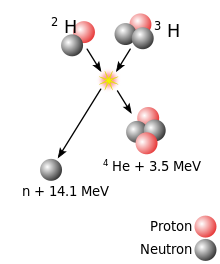Reaction of nuclear fussion
In nuclear physics, nuclear fusion is a nuclear reaction in which two or more atomic nuclei join together, or "fuse", to form a single heavier nucleus. During this process, matter is not conserved because some of the mass of the fusing nuclei is converted to energy which is released. Fusion is the process that powers active stars. The fusion of two nuclei with lower masses than iron (which, along with nickel, has the largest binding energy per nucleon) generally releases energy, while the fusion of nuclei heavier than iron absorbs energy. The opposite is true for the reverse process, nuclear fission.
This means that fusion generally occurs for lighter elements only, and
likewise, that fission normally occurs only for heavier elements. There
are extreme astrophysical events that can lead to short periods of fusion with heavier nuclei. This is the process that gives rise to nucleosynthesis, the creation of the heavy elements during events such as supernovae.
The fusion of two nuclei with lower masses than iron (which, along with nickel, has the largest binding energy per nucleon) generally releases energy, while the fusion of nuclei heavier than iron absorbs energy. The opposite is true for the reverse process, nuclear fission.
This means that fusion generally occurs for lighter elements only, and
likewise, that fission normally occurs only for heavier elements. There
are extreme astrophysical events that can lead to short periods of fusion with heavier nuclei. This is the process that gives rise to nucleosynthesis, the creation of the heavy elements during events such as supernovae.Building upon the nuclear transmutation experiments by Ernest Rutherford, carried out several years earlier, the laboratory fusion of heavy hydrogen isotopes was first accomplished by Mark Oliphant in 1932. During the remainder of that decade the steps of the main cycle of nuclear fusion in stars were worked out by Hans Bethe. Research into fusion for military purposes began in the early 1940s as part of the Manhattan Project, but this was not accomplished until 1951 (see the Greenhouse Item nuclear test), and nuclear fusion on a large scale in an explosion was first carried out on November 1, 1952, in the Ivy Mike hydrogen bomb test.
Research into developing controlled thermonuclear fusion for civil purposes also began in earnest in the 1950s, and it continues to this day. Two projects, the National Ignition Facility and ITER are in the process of reaching breakeven, that is, producing as much energy as was required to ignite the reaction, after 60 years of design improvements developed from previous experiments.






Jepang tuh salah satu negara yang (tadinya) sumber energinya nuklir. tapi habis kecelakaan kemaren, ngerusak semuanya. nuklir emang butuh dikembangin biar lebih ramah. mungkin biar jadi semacam geothermal energy, kan ramah tuh. bersikluss
ReplyDeleteyang nemuin nuklir itu siapa? einstein bukan? kalo gak salah ada ilmuan yang bilang yang intinya dia nyesel uda nemuin nuklir
ReplyDelete